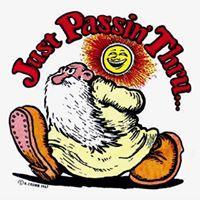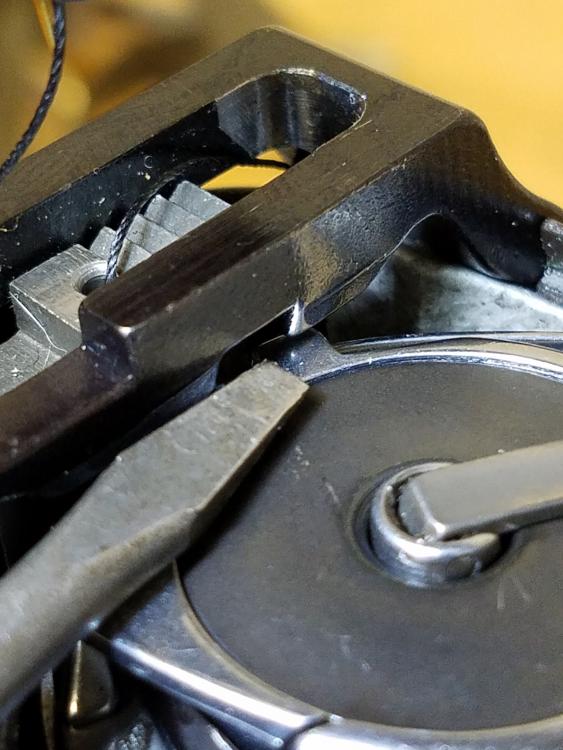-
Posts
19 -
Joined
-
Last visited
Contact Methods
-
Website URL
www.lcequipped.com
Profile Information
-
Gender
Male
-
Location
Lancaster, PA
Recent Profile Visitors
1,769 profile views
LunarConcepts's Achievements

Member (2/4)
-

Custom Table Top Maker Juki Lu-2828V-7
LunarConcepts replied to LunarConcepts's topic in Leather Sewing Machines
Thanks so much! I find a sticker on a big L shaped table I have for a 2828v-7 that looks to have been CNC's Company Name: AMERICAN TOPS, INC. Entity Type: NORTH CAROLINA DOMESTIC BUSINESS CORPORATION Filing State: North Carolina (NC) Products/Services: Manufacturing Workstation Tops | Architectural services Phone Number: (828) 397-6941 -
Hello, I am hoping to find some info on a U.S based custom table top maker that I can have CNC some larger stand tops for our Juki 2810s and 2828s. Ordering thru a dealer is an option but I want to delete some of the standard holes that most CNC shops cut for the standard tables as they are not used I am also looking to set the machine back further from the front edge and it seems that speaking with the maker direct might be the best option. Searching the web with no luck. Thank you
-
Anyone here have experience burning EPROMs for the Brother programmable stitchers? (KE434 and LKE434 machines with 100x60mm stitch area) I am limping my way through learning the software and have worked my way through drawing up the stitch patterns but I am not clear on how to save the files to then burn them to the EPROM. Working through the manual and following the instructions are not netting the expected results. I'd gladly pay time for some phone instruction on working through this. Thank you.
-
Recently picked up a Brother LS2-B837-310 with auto trim and back stitch. Spec on the machine is 8mm stitch length and it came barely making it to 7mm and the back stitch is around 5mm. I removed the back stitch solenoid and loosened any stops and ended up at a to long 11mm forwards stitch. I know on the LU-562/3 and similar you can fine tune the stitch balance by adjusting the feed regulating arm which is a bit different on this Brother. It appears that most of everything Brother uses a set screw in also has a locating hole, essentially pinning everything in place. The bigger issue is I have two of these machines and both are showing different stitch lengths and I'd like to tidy this up. Aesthetically equal stitches are more appealing but maybe this machine just wont allow adjustment? Or i am chasing it the wrong way? T.I.A!
-

Consew 227R, Adjusting Hook Assembly Height? Photos
LunarConcepts replied to LunarConcepts's topic in Leather Sewing Machines
Thank you for the info Bob. Looking at the set up it didn't look like it would let me shim it being tapered gears. Thank you Greg, I plan on pulling it apart and checking it After Christmas. I may give you a call if I find anything missing. I'd like to talk about the possibility of adding some pneumatic features to the Juki 1541 I bought from you as well as a Consew 255RB-3. I got a chance to run a Pfaff 1245 with air lift in place of the knee lifter and loved it. -

Consew 227R, Adjusting Hook Assembly Height? Photos
LunarConcepts replied to LunarConcepts's topic in Leather Sewing Machines
Thank you Uwe, I agree, I feel that the standard throat plate fitment isn't ideal. You never know what someone replaced or messed with when getting a used machines. My flatbed manuals talk about shimming the height of the hook assembly but that is completely different drive set up. Cylinder machine parts don't seem as common. I did look into the CW-8 series but could not find any information on binding throat plate for that model. It looks like there LCW-8 is a bigger machine and does show options for a binder plate in the parts manual but from the images, it doesn't look like it is quite the same. I believe I just found the part number for the Consew 227RBF which looks to have been the synchro binder version. I must have searched for 2 hours previously with no luck and found it in 10 minutes this time Screenshot for future reference Hopefully I can find one that is made to spec. Thanks again for the reply. -
I am curious if it is possible to adjust the hook height on a Consew 227R? I know there are options to shim standard flat bed machines but this is my first cylinder bed and the drive system is different and more compact. The issue I am having is that the bobbin case tab is barely engaging the slot in the needle plate. It can actually be bumped out with minimal effort. The machine is new to me from a retired purse maker. I am not sure if he had changed something. it will sew the way it is but... What I would like to do is set the machine up for binding small pouches/bags etc. I couldn't find much info on binder parts from Consew but it appeared it was a clone of the Singer 153 so I purchased the binder needle plate, and feed dog and rigged up a simple swing away carrier for a 90* attachment. On the binder plate the bobbin case tab slot actually sits approx 1mm higher then the case tab, sitting so low already, doesn't even touch the needle plate now. I need the hook assembly to ride approx 1mm higher. Any suggestions? Is this adjustable? Even with the stock plate is sits much lower then any of my flatbed machines. Photo 1 is with the standard needle plate. Photo 2 is with the binder needle plate installed. ( Feed dog is not yet adjusted to match the needle plate height)
-
Docado, Thank you! I was gonna just stay away from the problem today and avoid the headache. Your post prompted me to sit back down and look at it again. I went ahead and swapped up two sizes on the needle. I noticed that my bobbin was getting low and just figured I'd take care of that while be blood pressure was still down I started out on a 12" double layer of bias tape and noticed that the top tension was real high. Figured it was the larger hole the needed was making and made the appropriate adjustments. I went back and forth on that 12" pcs probably 30 times randomly throwing in back stitches. It was running like a champ! For education purposes, I threw the 19 needle back in place of the 21 (T90 thread) and it also sewed perfectly. I then threw the original bobbin in and it all went south! Turns out, I have better then a handful of bobbins that are "sticky" in the case and I just happen to have 3 of them in a row. Its a vertical axis machine and certain bobbins I have are getting pinch between the backlash spring and the bobbin hold down arm. some move freely up and down against the backlash spring tension but still drag on the hold down arm right where it folds over and contact the corner of the bobbin hole. You really notice how inconstant and jerky the bottom tension is, with the bad bobbins, when you pull on the bobbin thread when it isn't laced through the bottom tension spring. I have always sewn heavy webbing on this machine. I image that I never experience the problem prior barbecue I was always sewing with such high top stitch tension that it just overcame any lower tension inconsistencies. Thanks again for suggesting a helpful course of action.
-
Thanks for your reply. The machine went into service because it was in desperate need of a tune beyond set the timing and go. The machine would nest thread no matter what. The machine came back after service at Keystone and ran great. I'm looking for the tip as to why it sews great in forward and only messes up in reverse. It runs smooth when not actually threaded. There is something with either the thread deleivery or take up that is only happening when the R-lever is pressed. I have run the gammit of upper and lower tension to see if more or less would make a difference with no real favorable result. It does seem slightly better with more tensions or keeping the speed up. The proble is I am sewing inside of a 9x3x3" bag and you just cant go that fast. Thanks again!
-
Hello, The above mentioned machine was recently serviced. Since its been home, I have used it about 2 hours running heavy nylon belts with great results. It was then set up with a binding attachment and has seen minimal time just sewing some binding across maybe 50 2" pcs of webbing. The issue I am having is that it will sew forward with no issue but unpredictably it will not sew in reverse without trying to wrap the top thread up into the hook area or pluck strands off the braid causing them to pile up in the needle hole. The big change would be that I started binding a layer of Cordura and Diamond Ripstop edges together so my tension is down about 3 turns from where I was. I even went back to my previous settings and would say its only slightly better with thicker materials and more tension. I am using the same needle and thread though all this. When sewing and reversing with speed it seems to do better than when I'm just walking through starting a seam and want to back-stitch 3 or so stitches. Sometimes its great and others it nests up so quick you cant react. You can sew through four layers of binding tape up and back 5" and not have an issue. The first back stitch on your project and BAM! When sewing through material it is audibly louder with a clank, clank, clank in reverse. Without thread and material the machines sounds the same in both directions. Hook timing looks solid. reverse is just something I never had to play with so I don't know what to go after. Could the reverse "stop" have something to do with it? The machine came to me where the stop set that the stitch onnly revers at about a 3 length where I stitch more in the 5 range so I did lower the stop to better match the forward stitch length. Thanks for your suggestions.
-
Thanks for commenting! I have this almost entirely eliminated primarily through increasing the bobbin tension to what I would feel would be way to much but if it works.... Basically I got pissed off at the Juki and went back to my old Brother. I managed a relaxing 2 hours of making belts and when my head was in a good place I sat back down with the Juki and backed everything out and started working my way in. I would roll over to the Brother and give the top thread a pull and then back to the Juki to adjust the tension till my calibrated elbow felt they were the same for both machines. I did the same for the the bottom stitch and realized how much less the Juki was even after yo-yoing the bobbin case to get it into the normal tension range. I went for broke on the bottom tension and dialed it tighter with positive results and without an impact on the top stitch. I am going to give a thread luber a shot. This webbing sews up rock hard and the smoke rolls off the titanium coated needles. I would love to eek out a bit more top stitch tension which I am hoping will snug up the last little bit of slack on my corners Thanks again!
-
Thank you all, I will try turning the material prior to going past needle bottom. I always went past bottom on the Brother to make sure I didn't deflect the needle away from the hook and miss catching the corner stitch. This seems to be more of an issue when I am only sewing through a single layer. It is very frustrating as its usually right a the end of the project. It certainly kills the feeling of a successful finish. I have tried not raising or barely raising the presser to make sure it wasn't releasing the thread tension at all but really there is no load on the thread so I am not sure how it would? Gregg, Loving the new machine. All is well, I just need to get this last little thing figured out. The repair on the Brother has made it better than ever. Thanks for any additional input!
-
Hello, I recently purchase a Juki DNU1541S and I am having an issue with my bottom stitch making a loop whenever I make a turn (generally a 90*). I am sewing a heavy nylon webbing. I have been through increasing and decreasing both top and bottom stitch tension to the extreme. I have to run a decent amount of top stitch tension as this stiff is rigid and has a very tight weave. When I have the top stitch tension tight, it pulls the bottom stitch loop up through the material excessively to the point that my 90* corners are not crisp but rounded off. I can work with the top and bottom stitch tensions till it no longer pulls the bottom stitch through the material but then the loops start forming on the bottom side. This is normally only an issue for the first stitch after turning the material. All this is better shown in the picture. This is an issue I don't have on a Brother LS2- B837 and I am not sure if it has something to do with horizontal vs. vertical axis machine. Its almost like I am getting an excessive amount of slack when knee lifting the presser foot when turning. I did try actually just spinning the material under the foot without lifting and it made no notice improvement and in one instance made it worse I appreciate any suggestions. Thanks for a great forum.









